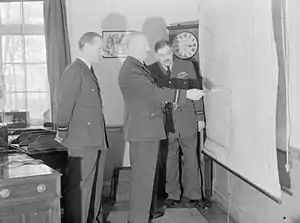Ronald Graham (RAF officer)
Air Vice Marshal Ronald Graham, CB, CBE, DSO, DSC & Bar, DFC (19 July 1896 – 23 June 1967) was a First World War flying ace of the Royal Naval Air Service. Remaining in the Royal Air Force after that war, he rose to the rank of air vice marshal during the Second World War.[1]
Ronald Graham | |
|---|---|
 Air Vice Marshal Graham (left), the Air Officer Administration at BCHQ, studying a map of Germany with Arthur Harris and Air Vice Marshal Saundby. | |
| Born | 19 July 1896 Yokohama, Japan |
| Died | 23 June 1967 (aged 70) Sannox, Isle of Arran, Scotland |
| Allegiance | United Kingdom |
| Service/ | Royal Navy (1915–18) Royal Air Force (1918–48) |
| Years of service | 1915–48 |
| Rank | Air Vice Marshal |
| Unit | Seaplane Defence Flight No. 13 Squadron RNAS |
| Commands held | RAF Staff College, Bracknell (1945) RAF Staff College, Bulstrode Park (1944–45) AHQ West Africa (1944) RAF Kenley (1930) No. 233 Squadron (1918–19) No. 213 Squadron (1918) Seaplane Defence Flight (1917–18) |
| Battles/wars | First World War Second World War |
| Awards | Companion of the Order of the Bath Commander of the Order of the British Empire Distinguished Service Order Distinguished Service Cross & Bar Distinguished Flying Cross Mentioned in Despatches Knight of the Legion of Honour (France) Croix de guerre (France) Officer of the Order of the Crown (Belgium) |
| Other work | Commandant of the Scottish Police College |
First World War
Graham was a medical student when the First World War began. In 1915, he joined the Royal Naval Division. In September, he pulled a lateral transfer into the Royal Naval Air Service as a flight sub-lieutenant. In 1916, he served at the Dover Seaplane Base. He then moved to Dunkirk, flying cover for the North Sea Fleet. During this time, he was forced into landing in the sea on two occasions. He became part of the Saint Pol Seaplane Defence Flight,[2] which formed on 30 June 1917.[3] Graham tallied his first two victories at this time, destroying a German seaplane on 19 June while piloting a Sopwith Baby, and another while piloting a Sopwith Pup on 12 August 1917; the latter was shared with Leonard Slatter.[1][2]
His unit morphed into No. 13 Squadron RNAS, sometimes referred to as 13 Naval Squadron. He switched to Sopwith Camels for his next three victories. He shared number three with Slatter, on 15 September, and destroyed two more, one each on 25 September and 19 October 1917. Then, on 29 December, while showboating for his nurse girlfriend, he crashed and seriously injured himself. After his convalescence, he returned to his squadron, which was now No. 213 Squadron RAF, and took command in May 1918.[2] In August 1918 he took command of the newly formed No.233 Squadron RAF which had a Fighter Defence Flight of Camels at RAF Walmer under the command of Captain W. M. Alexander, another Flight (491)at Dover (Guston Road)and the Seaplane flight (407) Dover, Marine Parade. In March 1919 the Squadron moved its headquarters to RAF Walmer. In total he was credited with five aerial victories.
Second World War
On the outbreak of the Second World War, Graham was an air commodore on the staff at the headquarters of Fighter Command.
Award citations
- Distinguished Service Cross
- Flight Sub-Lieutenant Ronald Grahame, R.N.A.S.
- "For exceptional gallantry in attacking and beating off four enemy seaplanes whilst on escort duty off the Belgian coast on the 22nd September, 1916."[4]
- Bar to the Distinguished Service Cross
- Flight Lieutenant Ronald Grahame, D.S.C., R.N.A.S.
- For conspicuous gallantry during raids on the seaplane station at Zeebrugge. On one occasion he descended to 600 feet, and on another occasion to 300 feet, before releasing his bombs.[5]
- Distinguished Service Order
- Acting Flight Lieutenant-Commander Ronald Graham, D.S.C., R.N.A.S
- For conspicuous gallantry and devotion to duty in air fights and bombing raids. Since the award of a bar to the Distinguished Service Cross, Act. Flt. Cdr. Graham has carried out five night bombing raids, and attacked and brought down three enemy seaplanes. On one occasion he ascended at night for the purpose of attacking hostile machines, notwithstanding the fact that he had only returned a few hours previously from a successful action with hostile aircraft in superior numbers. He has always displayed remarkable skill and courage.[6]
Notes
- "Ronald Graham". The Aerodrome. 2014. Retrieved 11 February 2015.
- Above the Trenches: A Complete Record of the Fighter Aces and Units of the British Empire Air Forces 1915–1920. p. 174.
- Royal Navy Aircraft Serials and Units 1911 to 1919. p. 435.
- "No. 29799". The London Gazette (Supplement). 25 October 1916. p. 10362.
- "No. 30066". The London Gazette (Supplement). 12 May 1917. p. 4626.
- "No. 30386". The London Gazette (Supplement). 17 November 1917. p. 11922.
References
- Sturtivant, Ray; Page, Gordon & Cronin, Dick (1992). Royal Navy aircraft serials and units 1911 to 1919. UK: Air-Britain (Historians). ISBN 978-0-85130-191-4.
- Shores, Christopher F.; Franks, Norman & Guest, Russell F. (1990). Above the Trenches: a Complete Record of the Fighter Aces and Units of the British Empire Air Forces 1915–1920. London, UK: Grub Street. ISBN 978-0-948817-19-9.
- Barass, M. B. (2015). "Air Vice-Marshal R. Graham". Air of Authority – A History of RAF Organisation.
| Military offices | ||
|---|---|---|
| Preceded by John Cole-Hamilton |
Air Officer Commanding AHQ West Africa January – December 1944 |
Succeeded by George Reid |
| Preceded by Charles Medhurst |
Commandant of the RAF Staff College, Bulstrode Park December 1944 – July 1945 |
Succeeded by Francis Mellersh |
| New title | Commandant of the RAF Staff College, Bracknell July – December 1945 |
Succeeded by Arthur Sanders |